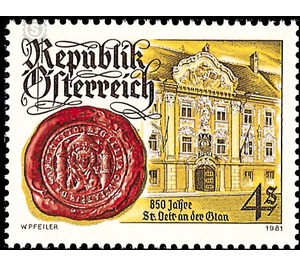850 years - Austria / II. Republic of Austria 1981 - 4 Shilling
Theme: Architecture
| Country | Austria / II. Republic of Austria |
| Issue Date | 1981 |
| Face Value | 4.00 |
| Color | brown red |
| Printing Type | combination printing |
| Stamp Type | Commemorative |
| Item Type | Stamp |
| Chronological Issue Number | 1018 |
| Chronological Chapter | OOS-OE2 |
| SID | 453496 |
| In 59 Wishlists | |
St. Veit is most likely from Glandorf, which was already mentioned in 979, emerged. The first mention of the hamlet of St. Veit happened only in 1131 in a Salzburg deed. In addition, there is a document from the year 1047, which states that Bishop Eberhard II of Bamberg has bought back the court of St. Veit with locks and accessories from the Margrave Engelbert. Barely 20 years later, the Sponheim Duke Hermann (1161-1181) acquired the city. He was the first Duke to reside in St. Veit. The Romanesque pillar basilica was built under it around 1170. The art historical center of the city was and is the main square, formerly called Oberer Platz. At its center is the plague column, which was created in the plague year of 1715 by Paduan sculptor Angelo de Putti, who had settled in St. Veit. The art historical most important building of the place and the whole city is the six-axle city hall with the beautiful gothic Kielbogenportal. The entire main front was provided by Marx Josef Pittner in 1754 with magnificent Baroque decor. The brand motif shows the gothic town hall crowned with a baroque gable, and on the left is the town seal, which dates back to 1250.


